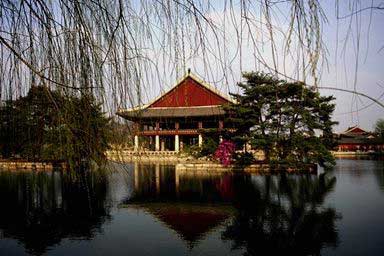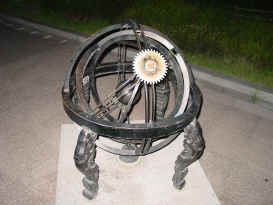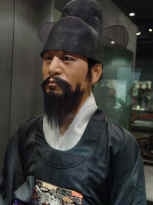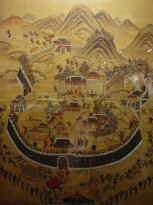|
EARLY CHOSON PERIOD
State Structure

Near the end of the Koryo Dynasty, 1389, General Yi Song-gye seized political
and military power, deposing King Ch'ang (r. 1388-1389) and placing King
Kongyang (r. 1389-1392) on the throne. He and capital in his fight against
the declining Koryo monarchy and nobility.
The Kwajonpop (rank land law) was instituted, providing not only land
for General Yi to distribute but also the power to rule the country. He
and his group were well aware that the ability to bring order and to end the
decadent Koryo Dynasty lay in the land tenure system.
Under the terms of status land system, land was ordinarily distributed for
life only, on the basis of one's status or rank. Recipients were given the
right to collect rents, while the peasant was given the right to
cultivate. The customary rent amounted to half the crop and was usually
paid as rent-tax to the state.
Since the peasant, as tenant, was guaranteed land tenure in terms of
cultivation rights, not subject to confiscation, his livelihood was
improved. In addition, the accumulation of land by the yangban, or
office-holding aristocrats, was strictly controlled by the stipulation that
status land would be granted only in the Kyonggi areas around the capital, where
the government could easily maintain supervision and surveillance.
By resolutely carrying out land reform, Yi Song-gye and his followers grasped
economic power. King Kongyang was forced to abdicate and Yi Song-gye's
followers placed Yi on the throne, bringing an end to the house of Wang.
Yi Song-gye renamed the dynasty Choson and he was given the dynastic name of
T'aejo. The establishment of institutions of Confucian learning was given
top priority in order to institute a Confucian state. A college and five
municipal schools were set up in Hanyang, and local schools were established in
all the magistracies. From these schools, Confucian-oriented
scholar-officials were recruited for government office.
Back to Top
The yangban class, acting in concert, had the power to interfere with
the monarchial administration and decision-making procedures. Under
Confucian precepts, the bureaucracy was to act as the agent of the monarch's
will, since the monarch had a vested interest in benevolent rule. The
monarch in turn had to heed the advice of the Confucian scholars. In this
connection, the Office of Royal Lecturers and the Office of State Councilors (Uijongbu)
were of prime importance. Below this were the six boards of administration
- civil appointment, taxation, rites, military, punishment and public works -
the principal government organizations in the capital. In provincial areas
administrative divisions and magistrates under provincial governors carried out
local administration.
The Censorate Offices submitted memorials and remonstrances to the monarch
and had the authority to ratify and rectify the monarch's appointment of
officials and his renovative decrees. The court historians, who were to
record daily happenings in the court and make verbatim records of the royal
conversation, were empowered to criticize the monarch and keep him under close
surveillance.
In order to enhance Confucian learning, movable metal type was cast for the
printing of Confucian classics and historical literature in 1403.
Typography was developed and improved by the repeated casting of new fonts as a
means of promoting Confucian studies for the welfare and prosperity of the
state.
Back to Top
King Sejong's Confucian Humanism

Choson's fourth king, King Sejong the Great (r. 1418-1450), was noted for his
mastery of Confucian learning. In addition to his embrace of Confucian
values, he showed himself able to successfully heal with the yangban
scholars. His rule in the mid-15th century was marked by progressive ideas
in administration, phonetics, national script, economics, science, music,
medical science and humanistic studies. He established the Chiphyonjon
(Hall of Worthies) in order to promote research in institutional tradition and
politico-economics.
King Sejong showed great concern for the livelihood of the peasants, providing
relief in time of drought and flood. He had Chong Ch'o compile the Nongsa
chiksol (Straight Talk on Farming), a volume replete with information
collected from experienced elder peasants throughout the country. The
first of its kind in Korea, this became the classic work on Korean
agriculture. He also put into effect a sliding tax scale which eased the
peasants' burden. King Sejong ordered the development of the pluviometer
in 1441 and distributed duplicates to the Office of Astronomy in Hanyang as well
as to local magistrates to record precipitation. This preceded Gastelli's
pluviometer of 1639 by almost 200 years.
Back to Top
One of his most celebrated achievements was the creation of the Korean
alphabet, Han-gul. Aware that his people must have a writing system
designed to express the language of their everyday speech, and desirous that all
his subjects be able to learn and use it, King Sejong impelled scholars of the
Hall of Worthies to devise the alphabet. The Korean alphabet, which
consists of 11 vowels and 17 consonants, posses geometric beauty, simplicity and
scientific accuracy, and as such, can be learned by an uneducated man in a
matter of hours.
Confucian scholars raised considerable opposition and protested that the use
of Korean script would retard Confucian studies. King Sejong persisted in
this determination to promote Han-gul for the benefit of the people, and Humin
Chong-um, of "The Correct Sounds for the Instruction of the
People," was distributed in 1446.
The official written language continued to be Chinese, as was Latin in
Europe, but now the Korean people had at their disposal a means of writing in
their own language. A bilingual poetic eulogy on the founding of the
dynasty Yongbioch'bon-ga (Songs of Flying Dragons) was composed in Korean
as well as in Chinese, and the Sokpo sangjol (Episodes From the Life of
the Buddha) was translated into Korean. These works laid the foundation
for the practical use of the Korean script.
King Sejong also showed his concern for the health of the people by ordering
the compilation of medical books. A 365 chapter compendium on Chinese
medicine as well as the Hyang-yak chipsongbang (A Compilation of Native
Korean Prescriptions) in 85 chapters, was completed in 1433. This latter
included 959 entries on disease diagnoses, 10,706 prescriptions, and 1,477 items
on acupuncture therapy. Another book on how to collect local medicinal
material was also published in the vernacular language.
Back to Top
King Sejong's interest in astronomical science was comprehensive and sun
dials, water clocks, orreries of the solar system, celestial globes,
astronomical maps, and atlases of the seven planets were produced at his
instigation. He had a notation system for Korean as well as Chinese music
devised or revised, and had on of his talented subject, Pak Yon, improve Korea's
musical instruments as well as commissioned the writing of music for Korean
musicians.
In foreign relations, King Sejong took strong measures against the Jurchen
tribes. The territory in the northeastern frontier area was restored and
six fortresses were established after General Kim Chong-so quelled the Jurchen
invaders in 1434. In 1443, King Sejong installed four counties on the
northern border, and opened three ports to the Japanese to help trade.
King Sejong's land tax reform, health policy and invention of the Korean
alphabet all contributed to the improvement of life of the people.
King Sejong was able to realize the Confucian state in the true sense of the
word. He also engendered a modern national consciousness in the minds of
the people. Although he had earlier confiscated temple lands and bondsmen
and otherwise restricted Buddhism, he later became especially devoted to that
faith after the death of his beloved Queen. His health declined during
that period, and he abdicated the throne to his son King Munjong (r.
1450-1452). Unfortunately, his legacy of stability and prosperity was not
sustained by his short-lived successors.
Back to Top
Monarchy versus Yangban

King Munjong's death in 1452 brought an 11-year-old Crown Prince to the
throne. State affairs were left in the hands of state councilors,
and monarchical power declined. In 1455, the unscrupulous Prince Suyang
taegun, uncle of the child-king Tanjong, usurped the throne by murder and
regicide after quelling the opposition; he also ruthlessly suppressed attempts
to restore Tanjong as king.
King Sejo (r. 1455-1468), as Prince Suyang
Taegun is officially known, closed
the Hall of Worthies, abolished some posts in the Censorate Offices, and
crippled the Office of Royal Lecturers (Kyong-yon), all measures designed
to loosen the ideological restraints on the monarchy. The Office of Study
Promotion was instituted, ostensibly as a means of promoting Confucianism.
In fact, it was used merely as a royal library rather than as an organization
designed to promote and propagate Confucian ideals. Further, he initiated
the practice of giving private audiences to individual officials, flouting the
regulation which made the presence of historians and censorate officials
mandatory at royal audiences.
An attempt to raise the status of the monarchy was, however, justified, as
the Korean monarch had formerly been vulnerable to inordinate yangban
pressure. Yang Song-ji, a talented scholar under King Sejong, advocated
the monarch's cause in his memorials. Yang stressed Korea's unique
position, asserting the need to preserve indigenous traditions. Tan-gun,
according to him, was the "Son-of-Heaven Ruler." He formulated the
proposition that Choson, like China, was a nation upon which the "Mandate
of Heaven" was bestowed. This argument strengthened King Sejo's hand
visa-vis the bureaucracy.
Back to Top
None of the Choson kings had been strong enough to defy the yangban
officials by praying in person at the Temple of Heaven, where the Song of Heaven
along was qualified to converse with the Heavenly God. King Sejo, however,
in his sacrificial ode to the Heavenly God at the Temple of Heaven, used the
phrase "the founder of the dynasty, the imperial great-great grandfather,
T'aejo (founder king Yi Song-gye)."
King Sejo ordered the compilation of a detailed map of Korea to provide
further control of outlying areas. Census-taking of all soldiers and
reserves in the various districts was enforced, and the Civil Register Act
required all citizens to carry identification tags. He installed large
military garrisons in each province and ordered every town to produce arms.
By arranging generous land grants and medicine, King Sejo showed his concern
for the welfare of the army. He also ordered the migration of people to
the sparsely populated northern border areas.
The monarch acted decisively in matters relating to the recruitment of new
officials, increasing the number of military graduates to further strengthen the
monarchial power. He also gave the title of "Meritorious
Subject" to various officials on three different occasions to widen the
base of loyal support. With the increase of inheritable land grants to
meritorious subjects, however, land available for the newly appointed officials
decreased. To solve this problem and to limit the economic power of the
officials and yangban, King Sejo instituted the official land system,
which allowed land grants in terms of rent for office tenure only. Thus
the status land system by which the yangban enjoyed lifetime tenure was
discontinued, and those parties who refused to compromise lost their land
holdings altogether. This limitation of land grants to incumbent officials
meant that the old landed yangban class changed to either an employed
bureaucracy with land or landless yangban with prestige only.
King Sejo offered interim civil and military service examinations more often,
in addition to the time-honored examinations given every three years.
Since the number of successful candidates in the interim examinations exceeded
those from fixed examinations by a ratio of two to one, this virtually brought
the civil examination system under the monarch's sway.
To divert the attention of the Neo-Confucian scholars, King Sejo defied
Confucian orthodoxy by support Taoism and Buddhism. An Office for
Publication of Buddhist Scriptures was established, where the compilation of
Buddhist literature and Korean translation of such literature became
active. Fifty copies of the bulky Tripitaka Koreana were printed
for distribution. To equip the often Sinocentric scholars with a
comprehensive history of their own country, the compilation of Tonggukt'onggam
(Comprehensive Mirror of the Eastern Kingdom) began in 1458 and was
completed after the king's death.
During this time, the compilation of the Kyongguk taejon (Grand Code
for State Administration) was initiated. The Kyongguk taejon became
the cornerstone of the dynastic administration and provided the monarchial
system with a sory of constitutional law in a written form.
Back to Top
Resurgence of Neo-Confucian Rule
The ninth King of Choson Dynasty, Songjong (r.1469-1494) ascended to the
throne as a child and ruled under the regency of the dowager queen and
minister-consultants. The anti-Sejo literati used the institution of the
royal lecture of try to abolish Buddhist rituals and other anomalies in the life
of the court, and the unfortunate child was subject to a rigorous schedule of
two and four royal lectures per day. The Office of Study Promotion was
expanded to serve as a censorate in addition to providing royal lecturers.
Heavy Confucian indoctrination was the order of the day, and state support of
Buddhism gradually diminished. During King Songjong's reign, officials'
rights to collect tax and rent from official land as personal income began to
wane.
Young scholars were treated well and given opportunities at the newly
established Hall of Leave for Study, and Confucianism once again found its place
in the royal administration. An ambitious publication program was
implemented, producing such works as a compendium of Korean historical
geography, also issued was an anthology of Korean-Chinese literature, as well as
an illustrated text on traditional music.
Such efforts to restore Confucian rule were not sufficient to satisfy the
scholarly class in general, however. Those among them who had suffered
discrimination during King Sejo's reign gained a foothold at court, but economic
conditions were not greatly improved. Following the implementation of a
central collection and distribution of rent policy on the officials' land, the
officials and yangban sought land control for the right to farm, thereby
encroaching upon the peasant's share of land ownership rights. Moreover,
land area grew as a result of reclamation, and this contributed further to the
growth of agricultural estates, a process which the dynasty attempted to
prevent. Some agricultural estates gathered bondsmen and peasants, many of
whom abandoned their free status in order to escape the heavy land tax, corvee,
and tribute taxes that have been imposed on them.
As the desire to hold landed interests became more intense, those yangban
who had already established themselves as the owners of meritorious subject
land, special land grants, reclaimed land, or accumulated landed rights to
cultivate land suddenly became targets of intense criticism.
Back to Top
Those literati who could not afford land became impoverished. These
literati upheld the family and clan rites and etiquette prescribed by
Neo-Confucian doctrine, but were impoverished by the costly rituals involved -
marriages, funeral and memorial ceremonies. To maintain themselves, they
depended heavily on their kinship ties, relying on assistance given by an
appointed official of the same kin group. These mutual assistance
relationships affected both officials in the capital, and landed yangban
in the outlying areas as well. This was also a key factor in the
politico-economic life of each yangban during the Choson Dynasty and was
intensified during King Songjong's reign. Kim Chong-jik (1432-1492) was a
leading scholar-official with many followers, who advocated the Neo-COnfucian
rectification theory which implied condemnation of King Sejo's usurpation.
His success represented for a while the peak of the resurgent Neo-Confucian
school.
King Songjong's successor in 1495 was King
Yonsan-gun, whose reign was noted
for his unscrupulous suppression of the literati. In the initial period,
he was hard-pressed by that clamorous group which opposed Buddhist rituals
observed at the death of the Queen mother. Infuriated by the hundreds of
memorials and protests made by the Neo-Confucian literati, King Yonsan-gun
lashed out at them. His first purge was based on an accusation of state
crimes because one of Kim Chong-jik's students had implicitly criticized King
Sejo's usurption in his historical notes. Through this purge and another
which followed in 1504, King Yonsan-gun eliminated the checks exercised by
historians, the censorate, and state councilors. Confucian statecraft
almost collapsed. His extraordinary anti-Confucian and anti-Buddhist acts
contravened the Kyongguk taejon and dismayed the yangban as a
whole until he was finally deposed.
It fell to King Chungjong (r. 1506-1544), supported by the officials who has
deposed King Yongsan-gun, to restore Confucian rule. The resurgence of the
Neo-Confucian school made the enhancement of the economic status of the literati
an urgent necessity. Some were rewarded with meritorious subject land, but
other found a solution through securing charters for private schools endowed
with some land and bondsmen. Such local private schools became the
intellectual training ground for new schools of thought.
Back to Top
The increase of refugee peasants contributed to the ever increasing burden of
taxes upon the remaining peasants. Cho Kwang-jo, an influential school
official, advocated the recommendation system for the recruitment of government
officials and the organization of local guilds to improve the impoverished
condition of the literati. The recommendation system was implemented and
his group was recruited for official posts, but this along did not satisfy them
since they were not rewarded with appropriate land. In 1519, the year they
achieved their goal of implementing the recommendation examination system, these
Neo-Confucian scholars faced a spurious charge of treason.
The ministers and the literati were often embroiled in royal succession
problems, and competed among themselves for places in the bureaucracy,
especially since their numbers had rapidly increased with the expansion of
private schools. Their common interests based on local school and kinship
organizations were bound to split them into factions, all the more bitterly
divided for being within the same status. The number of private schools
exceeded one hundred in the late 16th century, and eminent scholars of the
Neo-Confucian philosophy sheltered themselves in such institutions.
As for the people in general, they were hard-pressed by the levies of land
tax, corvee, military tax, service and especially tribute tax, which was
collected by authorized agents. The growth of agricultural estates
accelerated, contributing further to the decline of the peasant economy. A
righteous outlaw named Im Kkok-chong rose up against the greedy officials and
distributed it to the poor. He seized government granaries and gave relief
to hungry people in the provinces of Kyonggi-do and Hwanghae-do. Although
he was caught and beheaded in 1562, his chivalry and revolutionary ideas
captured the admiration of the people and inspired the popular novel, Hong
Kil-tong chon, the Tale of Hong Kil-Tong.
Back to Top
Resistance Against Japanese

The founder of Choson Dynasty, King T'aejo distinguished himself in his
resistance to Japanese marauders. After the latter's depredations had
ceased, Korea opened three ports for trade with Japanese feudal lords, giving
investiture to the Tsushima lord who had been engaged in lucrative trade with
other ranking Japanese. The Japanese liaison officers staying at these
ports caused trouble at times, however, and the amount of Choson's grant was
reduced.
After the assassination of Oda Nobunaga, who temporarily called a truce among
Japan's warring lords, Toyotomi Hideyoshi rose to power in 1590.
Hideyoshi's problem was to find a way to weaken the powerful feudal lords of the
western part of Japan. In this explosive domestic situation, he looked
abroad and decided that an invasion of China would provide the outlet needed for
a peaceful solution at home. When Choson rejected Hideyoshi's request for
aid in attacking China, he ordered his general to invade Ming and Choson in
1592. The Japanese army, armed with matchlock guns with which Choson
soldiers were not familiar, reached Hanyang within two weeks. They had
attempted to invade the granary Cholla-do province, only to meet the strong
resistance of the people led by General Kim Shi=min at Chinju. They then
turned back toward Hanyang.
King Sonjo and the royal princess fled to the northern provinces and appealed
to the Ming Emperor for aid against invaders. The Japanese generals
squabbled among themselves, while Choson's Admiral Yi Sun-shin conducted a
brilliant series of operations in the South Sea, destroying many Japanese
ships. The ironclad Kobukson (turtle ships), which Admiral Yi
improved with plated armor resembling a turtle shell, protected the sailors and
marines, and were more than a match for anything else afloat.
With the appearance of the allied Ming contingents, the Japanese were forced
to fight a combined Ming-Choson allied army. Cut off from supplies and
reinforcements owing to Admiral Yi's control of the sea, the Japanese were
severely weakened. A Choson volunteer army organized in the southern
provinces them with guerrilla tactics, while disease and malnutrition took its
toll. Peace negotiations were held between the Ming general and the
Japanese, who had by then lost the will to fight and started to retreat, stalked
by volunteer peasant forces and contingents of Buddhist monks.
Peace negotiations dragged on for five years but proved fruitless, and
Hideyoshi sent his army to Choson again in 1597. The invasion this time
encompassed only Kyongsang-do province and part of the Cholla-do province, as
the invaders were harassed by the volunteer army.
The Japanese retreated and Hideyoshi's death forced the evacuation of his
forces. Admiral Yi, in his attempt to smash the Japanese retreat, was
struck by a stray bullet and killed during the climactic naval battle. The
war ended at long last, with grave impact upon Choson, Ming China and Japan.

Back to Top
Impact of the War
The results of the Hideyoshi invasion brought about the destruction of
government records, cultural objects, archives, historical documents and many
works of art, the devastation of land, decrease in population, and the loss of
artisans and technicians. Arable land amounted to only one-third of the
prewar acreage, and the resulting decrease of revenue necessitated additional
taxation of less devastated provinces such as Kyonggi-do or Ch'oungch'dong-do.
The government resorted to selling official titles and yangban status,
and on occasion, held an examination for government service open to the bondsmen
class. The loss of artisans brought a decline in handiwork quality, as
well as in manufactured goods such as pottery and book printing. The
Neo-Confucian norms and values were shaken, and the class distinctions which the
yangban tried to uphold began to slowly crumble.
The Japanese, on the other hand, achieved a peaceful, centralized feudal
society under Hideyoshi's successor, Tokgawa Ieyasu. Importation of the
political philosophy of Neo-Confucianism and the study of medicinal materials
and therapy developed in Choson also helped Japanese scholars make significant
contributions to their society. The introduction of typography with
moveable metal type expedited book printing, and Choson artisans captured by the
Japanese army developed ceramic and textile products. After the Tokugawa
takeover, Japan wanted peaceful diplomatic relations with Choson in order to
benefit further from the Choson version of the Chinese culture.
For Ming China, however, the results were catastrophic. The economic
setback suffered in the campaign later let to the collapse of the dynasty in
1644.
Back to Top
|

